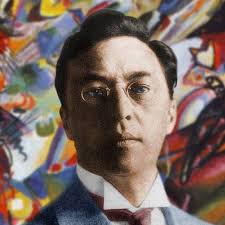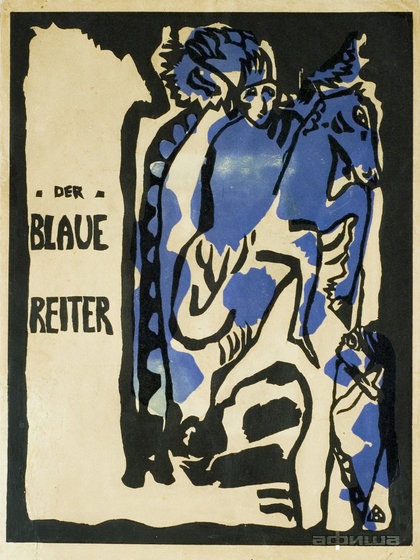“Colour is the keyboard, the eyes are the harmonies, the soul is the piano with many strings. The artist is the hand that plays, touching one key or another, to cause vibrations in the soul.”
The Colourful World of Kandinsky

For some, he was a revolutionary, while others considered him insane. In hindsight, the Russian painter, graphic artist and art theorist, was the founder of Abstract Expressionism and had a tremendous impact on the other artists of his day. We will look further into the periods influencing Kandinsky’s artistic evolution throughout his 77 years of living.
Wassily (Vasily) Wassilyevich Kandinsky born in 1866 in Moscow Russia, came from a diverse background, his father Mongolian, mother Muscovite (Russian), and grandmother from the German-speaking Baltic. At a young age, Kandinsky exhibited an extraordinary sensitivity toward the stimuli of sounds, words, and colours which became a deep influence in his art.
Despite his early exposure to the arts through private drawing classes, as well as piano and cello lessons, Kandinsky did not turn to painting until he reached the age of 30. Between 1886 and 1892 Kandinsky studied law and economics at the University of Moscow. In 1889 he was a member of a team formed to study the life of the people in the Vologda district in northwestern Russia. He was highly impressed by their folk art and the interior decorations of the village houses. The use of forms and colours carried with him throughout his career.
In 1901, along with three other young artists, Kandinsky co-founded “Phalanx.” They were an artist’s association that opposed to the conservative views of the traditional art institutions. Phalanx expanded to include an art school, in which Kandinsky taught, and an exhibitions group. There, he met and began a relationship with his student, Gabriele Munter, who became his companion for the next 15 years.

From 1903 until 1909, he travelled throughout Europe and northern Africa with Munter. Along his travels he familiarized himself with the growing Expressionist movement and developed his own style based on the diverse artistic sources.
When World War I broke out, Kandinsky returned to Moscow. Germany had declared war on Russia. Gabriele Münter moved to Stockholm and their relationship was over but they remained in touch.

In Moscow, Kandinsky continued his academic career as a professor. In 1917, he married Nina Andreievskaya, who was 27 years younger. She would later handle his estate.
Early Impressionist Influence

To my surprise, Kandinsky’s early work deviated from that of his later more abstract expressionist forms. He spent a lot of time in Murnau, in Bavaria, where he painted churches, villages and forests in brilliant colours, seen in his painting of the Bavarian Village.
His early work revealed his interest in disjointed figure-ground relationships and for him, the emotional impression that colours left was more important. Kandinsky was attracted to the impressionist style of Claude Monet. In Monet’s paintings the subject matter played a secondary role to color. That was the secret of Kandinsky’s early work, which was based on folk art, and it remained so even as his work became more complex.

The Blue Rider
In 1911 Kandinsky founded the Blue Rider group along with a number of Russian emigrants including Alexej von Jawlensky, Marianne von Werefkin, and native German artists Franz Marc, August Macke and Gabriele Münter. For Kandinsky, the rider was a metaphor for the artist which he explained in the Blue Rider Almanac,
“The horse carries the rider with strength and speed. But it is the rider who guides the horse. Talent will bring an artist to great heights with strength and speed. But it is the artist who directs his own talent.”

He designed the cover of the Blue Rider Almanac, with a horse and rider in mid-leap to represent the artist leaping across the distance that separates him from the art to come. This group embraced mysticism much more than the others Kandinsky had formed, focusing on revealing the associative properties of color, line and composition.

Kandinsky’s career took a third distinct shift when he moved back to Germany in 1922 to join the faculty of the Bauhaus( ‘School for Building’). The school’s philosophy flowed from the concept of the total work of art, the idea that all arts, architecture, fine arts, crafts, and design should be brought together. Kandinsky’s art from about 1920 to 1924 has been called his architectural period because the shapes he used were more precise than before. There are points, straight or broken lines, single or in bunches, and snakelike, radiating segments of circles, with cooler more subdued colours.
Kandinsky’s paintings were characterized by the abundant use of pictorial signs and softer colours. This is called his romantic or concrete period. It led to the last phase of his art, spent in France, which was a synthesis of his previous periods. The paintings of his Paris period have splendid colour, rich invention, and delightful humour.
A symphony of colours
Wassily Kandinsky was the artist who longed for a regeneration of the world through a new art of pure inwardness. He stressed the psychological effects of colour and inaugurated what came to be known as abstract art by his work of colour music.
Kandinsky experienced synesthesia, a rare but real condition in which one sense, like hearing, concurrently triggers another sense, such as sight. Kandinsky literally saw colours when he heard music, and heard music when he painted. This was reflected in The Yellow Sound, one of his experimental performance-based expressions of synesthesia. The Yellow Sound was a stage composition by Kandinsky involving pantomime, an instrumental ensemble, soprano solo and a mixed choir (1983).

While the Nazis confiscated 57 of his works, which they’d deemed “degenerate,” art fans from around the world traveled to Switzerland in 1937 to admire Kandinsky’s masterpieces in an exhibition.
In 1939 Kandinsky became a French citizen. He died December 13, 1944, in Neuilly-sur-Seine, France at the age of 77 – just a few months after the liberation of Paris. He always referred to abstract painting as the most difficult art form.
“It requires that one can draw, that one is highly sensitive for composition and colour and that one is a real poet – that’s most important.”
Kandinsky is still greatly admired today for his own paintings and for being the originator of abstract art. He invented a language of abstract forms with which he replaced the forms of nature. His artistic style evolved over three distinct periods in his life from the early phase of Impressionism, the Blue Rider, and his affiliation with Bauhaus. There is no doubt that Kandinsky felt that painting possessed the same power as music and that sign, line, and colour corresponding to the vibrations of the human soul.


Works Cited:
http://198.23.153.33/academy/lesson/art-of-wassily-kandinsky-periods-influences-architecture.html
https://issuu.com/artsfblog1/docs/kandinsky_-_russian_and_bauhaus_yea
https://issuu.com/powershift/docs/kandinsky_lithographs_online
https://www.artsy.net/artwork/wassily-kandinsky-stars
https://www.theartstory.org/artist/kandinsky-wassily/artworks/#pnt_6
2 replies on “Expressionism, Fauvism, & Early 20th Century”
Joanne,
Excellent work on Robert Henri. Nice choice of artist. Liked the variety of both old photos and slides of his work. Well paced and delivered in a confident and relaxed manner. Design of slides was very good as also. Liked you included influences as well. Well Done!
10/10
Jeff
Joanne,
Excellent post on Kandinsky! Thorough research and plenty of personal appeal and anecdotal insights. Your writing is scholarly and academic but not beyond being entertaining. Great work this term on these and look forward to your final post.
Jeff